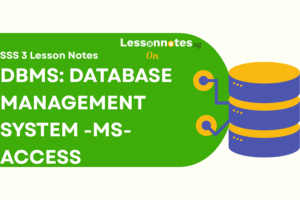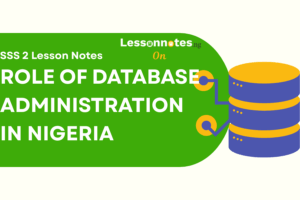File Organisation SS2 Data Processing Lesson Note
Download Lesson NoteTopic: File Organisation

File organization” refers to the logical relationships among the various records that constitute the file, particularly concerning the means of identification and access to any specific record.
“File structure” refers to the format of the label and data blocks and of any logical record control information. It is used to determine an efficient file organization for each base relation. For example, if we want to retrieve student records in alphabetical order of name, sorting the file by student name is a good file organization.
However, if we want to retrieve all students whose marks are in a certain range, a file ordered by the student’s name would not be a good file organization. Some file organizations are efficient for bulk loading data into the database but inefficient for retrieving and other activities.
The objective of this selection is to choose an optimal file organization for each relation.
TYPES OF FILE ORGANIZATION METHOD
- Serial: A serial file is one in which the records have been stored in the order in which they have arisen. They have not been sorted into any particular order. An example of a serial file is an unsorted transaction file. A shopping list is an example of a non-computerized serial file. Serial files can be stored on tape, disc or in memory.
- Sequential: In sequential file organization, records are organized in the sequence by which they were added. A sequential file contains records organized in the order they were entered. The order of the records is fixed. The records are stored and sorted in physical, contiguous blocks within each block the records are in sequence. Records in these files can only be read or written sequentially.
- Indexed: An indexed file organization contains reference numbers, like employee numbers, that identify a record of other records. These references are called the primary keys that are unique to a particular record. Alternate keys can also be defined to allow alternate methods of accessing the record. For example, instead of accessing an employee’s record using employee numbers, you can use an alternate key that references employees by department. This allows greater flexibility for users to randomly search through thousands of records in a file. However, it employs complex programming to be implemented.
- Random file: This is the file organized via an index. Also called a “direct file” or “direct access file,’’ it enables quick access to specific records or other elements within the file rather than having to read the file sequentially. The index points to a specific location within the file, and the file is read from that point.
COMPUTER FILES CLASSIFICATION:
- Master File: there are files of a fairly permanent nature, e.g. customer ledger, payroll, inventory, and so on. A feature to know is the regular updating of these files to show a current position. For example, a customer’s order will be processed, increasing the “balance owing “figure on a customer ledger record. It is seen therefore that master records will contain both data of a static nature, e.g. a customer name, and address, and data that, by its nature, will change each time a transaction occurs, e.g. the” balance” figure already mentioned.
- Transaction File: This is also known as movement file. This is made up of various transactions created from the source documents. In a sales ledger application, the file will contain all the orders received at a particular time. This file will be used to update the master file. As soon as it has been used for this purpose it is no longer required. It will therefore have a very short life because it will be replaced by a file containing the next batch of orders.
- Reference Files: A file with a reasonable amount of permanency. Examples of data used for reference purposes are price lists, tables of rates of pay, names and addresses
CRITERIA FOR CLASSIFYING COMPUTER FILES
Criteria for classifying computer files are:
- By nature of content: it refers to the nature of file content.
- By organization method: it refers to the way files are arranged e.g. Serial, sequential, random and so on.
- By storage medium: it refers to storage devices in which a file can only be stored such as magnetic or optical disk and magnetic tape and so on.






















